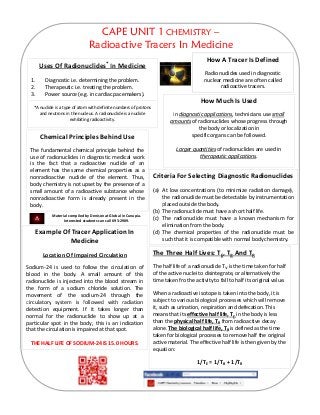
Cape Unit 1 Chemistry - Radioactive Tracers In Medicine
- 1. CAPE UNIT 1 CHEMISTRY – Radioactive Tracers In Medicine Uses Of Radionuclides* In Medicine How A Tracer Is Defined Uses Of Radionuclides In Medicine 1. Diagnostic i.e. determining the problem. 2. Therapeutic i.e. treating the problem. 3. Power source (e.g. in cardiac pacemakers). Radionuclides used in diagnostic nuclear medicine are often called radioactive tracers. *A nuclide is a type of atom with definite numbers of protons and neutrons in the nucleus A radionuclide is a nuclide How Much Is Used I di ti li ti t h i i lland neutrons in the nucleus. A radionuclide is a nuclide exhibiting radioactivity. In diagnostic applications, technicians use small amounts of radionuclides whose progress through the body or localization in specific organs can be followed. Larger quantities of radionuclides are used in therapeutic applications. Chemical Principles Behind Use The fundamental chemical principle behind the use of radionuclides in diagnostic medical work is the fact that a radioactive nuclide of an element has the same chemical properties as a nonradioactive nuclide of the element. Thus, body chemistry is not upset by the presence of a small amount of a radioactive substance whose nonradioactive form is already present in the body. Criteria For Selecting Diagnostic Radionuclides (a) At low concentrations (to minimize radiation damage), the radionuclide must be detectable by instrumentation placed outside the body.y p y (b) The radionuclide must have a short half life. (c) The radionuclide must have a known mechanism for elimination from the body. (d) The chemical properties of the radionuclide must be such that it is compatible with normal body chemistry. Example Of Tracer Application In Medicine Location Of Impaired Circulation The Three Half Lives: TE, TB And TR Material compiled by Denison at Global in Cunupia. Interested students can call 693‐2909. Location Of Impaired Circulation Sodium‐24 is used to follow the circulation of blood in the body. A small amount of this radionuclide is injected into the blood stream in the form of a sodium chloride solution. The movement of the sodium‐24 through the circulatory system is followed with radiation The Three Half Lives: TE, TB And TR The half life of a radionuclide T½ is the time taken for half of the active nuclei to disintegrate, or alternatively the time taken fro the activity to fall to half its original value. When a radioactive isotope is taken into the body, it is subject to various biological processes which will removecirculatory system is followed with radiation detection equipment. If it takes longer than normal for the radionuclide to show up at a particular spot in the body, this is an indication that the circulation is impaired at that spot. THE HALF LIFE OF SODIUM‐24 IS 15.0 HOURS. subject to various biological processes which will remove it, such as urination, respiration and defecation. This means that its effective half life, TE in the body is less than the physical half life, TR from radioactive decay alone. The biological half life, TB is defined as the time taken for biological processes to remove half the original active material. The effective half life is then given by the equation:equation: 1/TE = 1/TB + 1/TR
